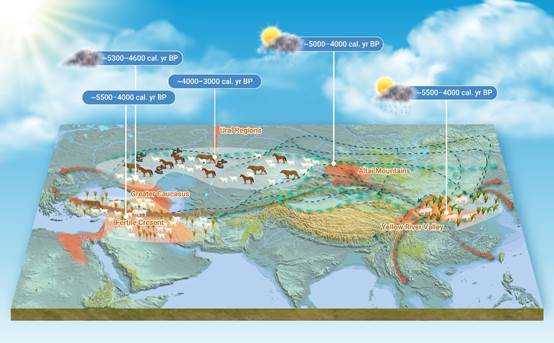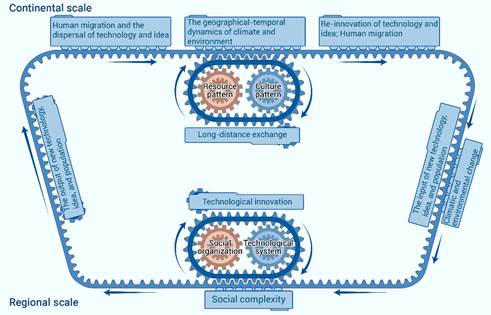The mutual exchange and global development among different civilizational entities during the late Neolithic to the Bronze Age marked a significant wave in human society. The evolution and dynamics of human-environment relationships during this period have garnered widespread attention from various disciplines, including archaeology, genetics, paleoenvironmental, and paleoclimate sciences. However, due to its vastness and complexity, research on the evolution processes and mechanisms of human-environment relationships during this period is mostly concentrated at the regional scale. There is a lack of exploration into the interaction and associated mechanisms of continental-scale human-environment systems.
In response to these challenges, Professor Dong Guanghui from the School of Resources and Environmental Science at Lanzhou University, along with Dr. Liu Ruiliang from the British Museum, utilized the positional information of 2799 archaeological sites and 439 sets of archaeological data on plants and animals in the mid-latitude Eurasian region. They traced the spatiotemporal changes in the primary human settlement centers and strategies for the utilization of flora and fauna resources from 6000 to 3000 years ago. Based on this, and through comparisons with studies in paleoenvironment and paleoclimate, they proposed a conceptual model outlining the interactive mechanisms influencing the socio-spatial development patterns in the mid-latitude Eurasian region from 6000 to 3000 years ago, considering factors such as climate change, natural resource patterns, technological and social organizational innovations, and long-distance transmission.

Figure 1: Diagram illustrating socio-economic development and cross-cultural exchanges in the mid-latitude Eurasian region from 6000 to 3000 years ago
In this model, different factors like climate change, natural resource endowment, technological and social organizational innovations, human migration, and cultural dissemination exhibit dynamic interconnections. At the regional scale, the interaction between social organization and technological system innovation propels the process of societal complexity, with climate change potentially playing a facilitating role. The improvement in resource development efficiency stimulates rapid population growth at the regional level, leading to the dispersion of some populations to sparsely populated or uninhabited areas. At the continental scale, the long-distance transmission of technologies, lifestyles, thoughts, and beliefs through population migration, communication, trade, or warfare profoundly influences the social evolution processes in major passages and surrounding areas such as the Eurasian steppe and oasis corridor. The compatibility of new cultural systems with the natural resource endowment of different geographical units significantly impacts the socio-spatial patterns of human society development. For example, around 6500 to 3600 years ago, during a warm period in the Altai region, the introduction of livestock and crops about 5200 years ago created favorable environmental conditions for herding sheep and cattle and cultivating wheat, barley, and millet, making the region one of the primary settlement centers in the Bronze Age. The early rise of metallurgy made the Altai region and the Ural Mountains, rich in metal deposits, hotspots for human development around 4000 to 3000 years ago. These phenomena, to some extent, shaped and changed the cultural-geographical patterns of the mid-latitude Eurasian region at different times, and climatic environmental changes are one of its important influencing factors. Cross-regional exchanges further promote new technological and social innovations, accelerating their long-distance diffusion, thereby profoundly affecting the socio-spatial patterns of human society development at the regional scale. For example, drought-resistant crops like barley and livestock (sheep and cattle) were introduced to the northeastern edge of the Qinghai-Tibet Plateau about 4000 years ago, and their utilization facilitated the large-scale permanent settlement of humans in high-altitude areas 3600 years later. In summary, continuous interregional or regional exchanges influence the human-environment systems of different regions, and the intertwining and coupling of social and natural factors closely link regional and continental-scale human-environment systems. Their interactions significantly impacted the socio-spatial patterns of cultural geography in the mid-latitude Eurasian region from 6000 to 3000 years ago (Figure 2). This study removes the limitations of a single research scale, significantly reduces the complexity of key influencing factors behind complex phenomena, and elucidates the specific mechanisms of the various factors, contributing to a rational, logical, and systematic understanding of the establishment process of the new order in human-environment relationships.

Figure 2: Gear model illustrating the dynamic effects of various factors in regional and continental-scale human-environment systems
The relevant findings, titled "Human-environment interaction systems between regional and continental scales in mid-latitude Eurasia during 6000–3000 years ago," have been recently published in The Innovation Geoscience. Professor Dong Guanghui from the School of Resources and Environmental Science at Lanzhou University is the first author, and he and Dr. Liu Ruiliang from the British Museum are co-corresponding authors.
Original link:https://doi.org/10.59717/j.xinn-geo.2023.100038